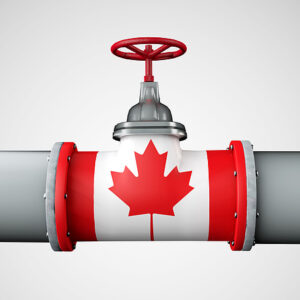When President Donald Trump announced plans to slap a 10 percent tariff on oil and gas imports from Canada, he shined an uncomfortable spotlight on a little-known fact about American households.
Millions of them rely on Canadian oil to keep warm.
While the idea of a tank full of heating oil firing up the furnace may sound quaint to some, it’s how nearly five million U.S. households heated their home in 2023, according to the United States Energy Information Administration. About 80 percent of them are in the Northeast. In New Hampshire, more than 40 percent of residents use home heating oil, and it Maine it’s more than half.
Much of that oil comes, not from Texas or Oklahoma, but from Canada. As a result, the National Energy Assistance Directors Association the cost of oil-based heating would increase by $117 to $1,576 on average if Trump’s tariffs take effect.
America imports Canadian oil because of its proximity and the network of established pipelines that serve both nations. But it also uses Canadian oil because it’s the sort of heavy crude similar to the oil from California that many U.S. refineries are designed to process.
Around 25 percent of all oil refined in America comes from Canada.
The alternative to heating oil is natural gas. Cheaper to produce – and healthier for the environment – it accounts for 43.1 percent of electricity generation in the U.S., according to federal statistics.
Not only that, but Pennsylvania, America’s second-largest producer of natural gas, could easily provide the natural gas needed to replace heating oil demand in the region.
And so, while the public policy debate has largely focused on the tariff policy, people in the energy sector are asking another question: Why are so many Americans still burning oil when the U.S. is the largest producer of cleaner natural gas?
Because of a successful effort by the Biden administration and its green allies to block energy infrastructure to take natural gas where it’s most needed.
There have been many pipeline proposals to take natural gas from the prolific Marcellus and Utica shale regions of Pennsylvania, says Marc Brown with Consumer Energy Alliance. But those proposals ran into heavy resistance, particularly in blue states like Massachusetts and New York.
“Any one of those projects would have reduced energy prices, increased the electricity grid’s reliability, and reduced emissions.”
Supporters of expanded U.S. natural gas note the irony of environmental activists and Democratic governors going to court to keep more Americans burning imported oil.
New York banned fracking in 2014 after a six-year moratorium sparked by unverified environmental concerns, despite a 2009 ConEdison report praising the state’s “safe, robust natural gas infrastructure,” including 10 pipelines.
Natural gas allies received a boost in 2012 when the U.S. Energy Information Administration (EIA) argued prices would likely drop if a pipeline from New Jersey to New York was expanded. The EIA said the expanded pipeline would help reduce bottlenecks from natural gas rich Pennsylvania to New Hampshire and the rest of New England.
But three years after New York banned fracking, the administration of then-Gov. Andrew Cuomo (D) halted two major natural gas pipelines from Pennsylvania.
In Massachusetts, Gov. Maura Healey (D) recently demanded energy companies lower their prices after the state’s public utilities commission approved a 25 percent price increase on natural gas. But the progressive Democrat previously bragged that she “stopped two pipelines from coming into this state.”
Access to natural gas in the Bay State has become so problematic that in 2018 and 2019, some Massachusetts utilities issued moratoriums on new residential natural gas hookups due to “insufficient pipeline capacity.” Energy companies shifted focus to truck transportation of oil and natural gas, extending delivery time of shipments – and driving up costs.
But that could change under the Trump administration, Brown said.
“Hopefully, projects receive approvals so that they can deliver much-needed relief to families and businesses–especially to those on low and fixed incomes that can least afford the exorbitantly high energy prices we see in the Northeast.”
And it may already be happening.
Trump has vowed to revive the proposed Constitution Pipeline from Pennsylvania to New York that was abandoned in 2020.
“It will bring down the energy prices in New York and in all of New England by 50, 60, 70 percent,” Trump said.

